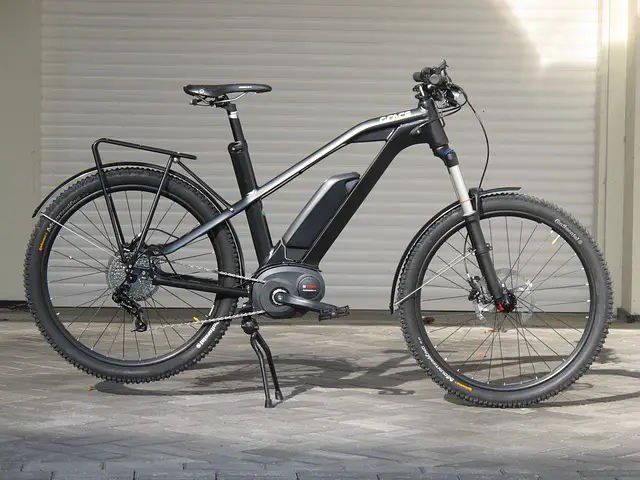
Electric bikes, or e-bikes, have gained significant popularity in recent years as an eco-friendly and efficient mode of transportation. These bikes combine the convenience of traditional bicycles with the added assistance of an electric motor, making them ideal for commuting, leisure rides, and even off-road adventures. However, one aspect that can impact the performance and overall experience of an e-bike is its weight.
Reducing the weight of an e-bike can bring several benefits. Firstly, a lighter e-bike is easier to handle and maneuver, providing a more enjoyable and responsive riding experience. It can also improve acceleration and climbing capabilities, allowing riders to tackle hilly terrains with greater ease. Additionally, a lighter e-bike requires less energy from the electric motor, resulting in extended battery life and increased range.
In this guide, we will explore various strategies to help you reduce the weight of your e-bike, enhancing its performance and efficiency. We will delve into different aspects of the bike, including materials, components, accessories, and personal belongings, providing practical tips and recommendations along the way.
Now, let’s dive into the various strategies and techniques that can help you shed pounds from your e-bike, allowing you to enjoy a lighter, more agile, and efficient ride.
Assessing the Current Weight
Weighing the e-bike:
The first step in reducing the weight of your e-bike is to weigh it. Use a reliable and accurate scale to measure the overall weight of the bike, including all components and accessories. This will serve as a baseline for tracking your progress as you make changes to reduce weight.
Identifying the Components Contributing to Weight:
Once you have determined the overall weight of your e-bike, it’s important to identify the components that contribute the most to its weight. Typically, the major contributors to weight include the frame, battery, motor, drivetrain components, wheels, and suspension system. Assess each component to determine its weight and evaluate whether there are opportunities for reduction.
Frame:
The frame is a significant contributor to the weight of an e-bike. Consider the material of the frame and explore lightweight options such as aluminum or carbon fiber, which can provide strength and durability while reducing weight. However, ensure that the chosen material maintains the necessary structural integrity to support the motor and battery.
Battery:
E-bike batteries are crucial for providing power to the motor. While it’s important to have a battery with sufficient capacity for your needs, consider lighter battery options without compromising range. Lithium-ion batteries are commonly used in e-bikes due to their high energy density and relatively low weight.
Motor:
The motor is another significant component contributing to the weight of an e-bike. While it may not be feasible to change the motor entirely, you can explore lighter motor options when purchasing or upgrading your e-bike. Look for motors with high power-to-weight ratios that can provide sufficient assistance while being lightweight.
Drivetrain components:
The drivetrain, including the chain, cassette, crankset, and derailleurs, can add considerable weight to an e-bike. Consider upgrading to lighter and more efficient drivetrain components. Look for options made from lightweight materials such as aluminum or titanium, and consider using single-chainring setups for simplicity and weight reduction.
Wheels:
The wheels of an e-bike can significantly affect its weight and performance. Consider lighter wheelsets made from materials like carbon fiber or aluminum alloy. Additionally, opt for lighter, narrower tires that can reduce rotational weight and rolling resistance without compromising stability and traction.
Suspension system:
If your e-bike has a suspension system, such as front forks or rear shocks, evaluate their weight and performance. Consider lighter suspension options without sacrificing functionality and comfort.
Choosing Lightweight Materials
Frame Materials:
Aluminum:
Aluminum frames are a popular choice for e-bikes due to their lightweight nature and affordability. They offer a good balance between weight reduction, strength, and cost-effectiveness. Look for frames with hydro formed or butted tubes, as they provide strength where needed while reducing unnecessary weight.
Carbon Fiber Frams:
Carbon fiber frames offer excellent weight reduction potential while maintaining strength and stiffness. They are often found in high-end e-bike models. Carbon fiber frames can absorb vibrations, providing a smoother ride. However, they tend to be more expensive than aluminum frames.
Fork and Handlebar Materials:
Carbon Fiber Forks:
Similar to frames, carbon fiber forks and handlebars offer weight savings without compromising strength or rigidity. They can help reduce the weight of the front end, improving handling and responsiveness. Carbon fiber handlebars also have the added benefit of absorbing road vibrations, enhancing rider comfort.
Aluminum Alloy:
For those seeking a more budget-friendly option, aluminum alloy forks and handlebars are lightweight and provide good durability. Look for options with butted or tapered designs to save weight without sacrificing strength.
Wheelset and Tire Selection:
Lightweight Wheelsets:
Consider upgrading to lighter wheelsets made from materials like carbon fiber or high-quality aluminum alloy. These materials offer weight savings without compromising strength or durability. Look for options with aerodynamic designs to further enhance efficiency.
Narrower Tires:
Opt for narrower tires, as they tend to be lighter and have lower rolling resistance. However, ensure that the chosen tires still provide adequate grip and traction for your riding conditions.
Seat and Saddle Materials:
Lightweight Seatposts:
Replace heavy seatposts with lightweight alternatives made from materials like carbon fiber or high-strength aluminum alloys. This can help reduce weight without compromising comfort or adjustability.
Performance Saddle:
Consider investing in a performance-oriented saddle that strikes a balance between weight, comfort, and support. Look for saddles with lightweight materials and ergonomic designs to enhance your riding experience.
Streamlining Components
Upgrading to Lighter Drivetrain Components:
Chainring:
Consider switching to a single-chainring setup, also known as a 1x drivetrain. This eliminates the front derailleur, chainring, and associated components, reducing weight and simplifying the drivetrain. Additionally, look for lightweight chainrings made from materials like aluminum or titanium.
Cassette:
Opt for a cassette with a wide range of gears but made from lightweight materials, such as high-strength steel or aluminum. This reduces rotational weight while still providing gear options for various riding conditions.
Chain:
Choose a lightweight and durable chain designed specifically for e-bike use. Look for options made from high-grade alloys that offer good strength-to-weight ratios.
Derailleurs:
Consider upgrading to lightweight derailleurs made from materials like carbon fiber or aluminum alloy. Look for models that maintain smooth shifting performance while reducing weight.
Choosing Lightweight Batteries:
Lithium-ion Batteries:
Lithium-ion batteries are the standard for e-bikes due to their high energy density and relatively low weight. When replacing or upgrading your battery, look for models that offer high capacity while keeping weight to a minimum.
Battery Mounting:
Explore lightweight battery mounting solutions that provide secure attachment while minimizing weight. Some e-bikes offer integrated or semi-integrated battery systems that reduce weight by eliminating the need for additional brackets or attachments.
Lighter Brake Systems:
Disc Brakes:
Opt for lightweight hydraulic disc brake systems that provide reliable stopping power. Look for calipers made from lightweight materials such as aluminum, and rotors with optimized designs that reduce weight without compromising braking performance.
Rotor Size:
Consider the appropriate rotor size for your riding needs. Larger rotors generally offer better heat dissipation and improved braking performance, but they also add weight. Choose the rotor size that strikes a balance between weight reduction and braking efficiency.
Lightweight Suspension Systems:
Air Suspension:
Consider air-sprung suspension forks and rear shocks, as they are generally lighter than coil-sprung counterparts. Air suspension systems allow for easy adjustment of sag and rebound, enhancing the bike’s performance and comfort.
Carbon Fiber Components:
Explore carbon fiber options for suspension components such as fork lowers or shock linkages. Carbon fiber can offer weight savings without compromising structural integrity or damping performance.
Eliminating Unnecessary Accessories
Assessing and Removing Non-Essential Accessories:
Carry Rack:
If you rarely use a carry rack or panniers, consider removing them. These accessories can add significant weight to your e-bike. Instead, opt for a lightweight backpack or saddlebag for carrying essentials when needed.
Fenders:
Evaluate whether fenders are essential for your riding conditions. While fenders can be useful for keeping you dry in wet conditions, they can also add weight. If you ride mainly in dry weather, consider removing the fenders to reduce weight.
Lights:
If you have heavy or bulky lights that are not necessary for your regular rides, consider switching to lightweight and compact options. LED lights are typically lighter and more efficient than traditional halogen lights.
Bells and Horns:
While safety is important, assess the necessity of bells or horns based on your riding environment. If you rarely encounter crowded areas or require audible signals, removing them can help reduce weight.
Opting for Lightweight Alternatives:
Pedals:
Choose lightweight pedals made from materials such as aluminum or titanium. Look for options that offer a good balance of weight, grip, and durability.
Handlebar Grips:
Consider lightweight foam or silicone grips that provide comfort and vibration dampening without adding unnecessary weight.
Saddlebag and Tool Kit:
Evaluate the contents of your saddlebag and tool kit. Remove any unnecessary or duplicate items to reduce weight. Opt for lightweight multi-tools and compact repair kits.
Water Bottle Cage:
Choose lightweight water bottle cages made from materials like carbon fiber or lightweight aluminum alloy. These cages can significantly reduce weight while securely holding your water bottle.
Personal Belongings:
Minimizing Carried Items:
Review the items you typically carry while riding. Minimize the number of unnecessary items to reduce weight. Carry only essentials such as a spare tube, tire levers, a small pump, and a lightweight rain jacket, if needed.
Lightweight Accessories for Storage:
If you need to carry items on your e-bike, consider lightweight storage options such as frame bags or handlebar bags. These minimize weight compared to larger backpacks or panniers.
Conclusion:
Reducing the weight of an e-bike can enhance its performance, efficiency, and overall riding experience. By following the strategies outlined in this guide, you can make significant progress in shedding pounds from your e-bike without compromising its structural integrity or functionality.
Assessing the current weight of your e-bike and identifying the components that contribute the most to its weight is the first step. From there, choosing lightweight materials for the frame, forks, handlebars, and other components can make a noticeable difference. Upgrading to lighter drivetrain components, batteries, and brake systems can further reduce weight while maintaining performance.
